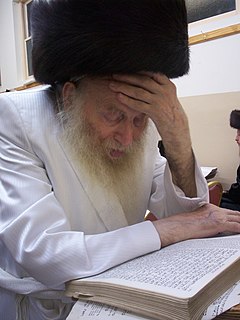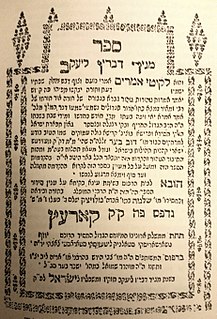Abba Arikha (175–247), commonly known as Rav, was a Jewish amora of the 3rd century. He was born and lived in Kafri, Sassanid Babylonia. He established at Sura the systematic study of the rabbinic traditions, which, using the Mishnah as text, led to the compilation of the Talmud. With him began the long period of ascendancy of the great academies of Babylonia, around the year 220. In the Talmud, he is frequently associated with Samuel of Nehardea, with whom he debated on many major issues.

Shlomo Yitzchaki, today generally known by the acronym Rashi, was a medieval French rabbi and author of a comprehensive commentary on the Talmud and commentary on the Tanakh. Acclaimed for his ability to present the basic meaning of the text in a concise and lucid fashion, Rashi appeals to both learned scholars and beginner students, and his works remain a centerpiece of contemporary Jewish study. His commentary on the Talmud, which covers nearly all of the Babylonian Talmud, has been included in every edition of the Talmud since its first printing by Daniel Bomberg in the 1520s. His commentary on Tanakh—especially on the Chumash — serves as the basis for more than 300 "supercommentaries" which analyze Rashi's choice of language and citations, penned by some of the greatest names in rabbinic literature.
In Judaism, a rabbi is a teacher of Torah. The basic form of the rabbi developed in the Pharisaic and Talmudic era, when learned teachers assembled to codify Judaism's written and oral laws. The first sage for whom the Mishnah uses the title of rabbi was Yohanan ben Zakkai, active in the early-to-mid first century CE. In more recent centuries, the duties of a rabbi became increasingly influenced by the duties of the Protestant Christian minister, hence the title "pulpit rabbis", and in 19th-century Germany and the United States rabbinic activities including sermons, pastoral counseling, and representing the community to the outside, all increased in importance.

Rebbe is a Yiddish word derived from the Hebrew word rabbi, which means "master", "teacher", or "mentor". Like the title rabbi, it refers to teachers of Torah or leaders of Judaism.

Rabbi Dov Baer ben Avraham of Mezeritch, also known as the Maggid of Mezritch, was a disciple of Rabbi Yisrael Baal Shem Tov, the founder of Hasidic Judaism, and was chosen as his successor to lead the early movement. Rabbi Dov Baer is regarded as the first systematic exponent of the mystical philosophy underlying the teachings of the Baal Shem Tov, and through his teaching and leadership, the main architect of the movement. He established his base in Mezhirichi, which moved the centre of Hasidism from the Baal Shem Tov's Medzhybizh, where he focused his attention on raising a close circle of great disciples to spread the movement. After his death, avoiding the unified leadership of the first two generations, this third generation of leadership took their different interpretations and disseminated across appointed regions of Eastern Europe. Under the inspiration of their teacher, this rapidly spread Hasidism beyond Ukraine, to Poland, Galicia and Russia.

Isaac Luria Ashkenazi, commonly known in Jewish religious circles as "Ha'ARI", "Ha'ARI Hakadosh" [the holy ARI] or "ARIZaL" [the ARI, Of Blessed Memory ], was a foremost rabbi and Jewish mystic in the community of Safed in the Galilee region of Ottoman Syria. He is considered the father of contemporary Kabbalah, his teachings being referred to as Lurianic Kabbalah. While his direct literary contribution to the Kabbalistic school of Safed was extremely minute, his spiritual fame led to their veneration and the acceptance of his authority. The works of his disciples compiled his oral teachings into writing. Every custom of the Ari was scrutinized, and many were accepted, even against previous practice.
Semikhah or Smicha or Smicha, also smichut, smicha lerabbanut, or smicha lehazzanut, is derived from a Hebrew word which means to "rely on" or "to be authorized".

Elijah ben Solomon Zalman, known as the Vilna Gaon or Elijah of Vilna, or by his Hebrew acronym HaGra or Elijah Ben Solomon, was a Talmudist, halakhist, kabbalist, and the foremost leader of misnagdic (non-hasidic) Jewry of the past few centuries. He is commonly referred to in Hebrew as ha-Gaon he-Chasid mi-Vilna, "the pious genius from Vilnius".

In Christianity, disciple primarily refers to a dedicated follower of Jesus. This term is found in the New Testament only in the Gospels and Acts. In the ancient world a disciple is a follower or adherent of a teacher. It is not the same as being a student in the modern sense. A disciple in the ancient biblical world actively imitated both the life and teaching of the master. It was a deliberate apprenticeship which made the fully formed disciple a living copy of the master.

Moses Schreiber (1762–1839), known to his own community and Jewish posterity in the Hebrew translation as Moshe Sofer, also known by his main work Chatam Sofer, Chasam Sofer or Hatam Sofer,, was one of the leading Orthodox rabbis of European Jewry in the first half of the nineteenth century.

Rabbi Yehuda Ashlag (1885–1954) or Yehuda Leib Ha-Levi Ashlag, also known as the Baal Ha-Sulam in reference to his magnum opus, was an orthodox rabbi and kabbalist born in Łódź, Congress Poland, Russian Empire, to a family of scholars connected to the Hasidic courts of Porisov and Belz. Rabbi Ashlag lived in the Holy Land from 1922 until his death in 1954. In addition to his Sulam commentary on the Zohar, his other primary work, Talmud Eser Sefirot is regarded as the central textbook for students of Kabbalah. Ashlag systematically interpreted the wisdom and promoted its wide dissemination. In line with his directives, many contemporary adherents of Ashlag’s teachings strive to spread Kabbalah to the masses.

John 20:16 is the sixteenth verse in the twentieth chapter of the Gospel of John in the Bible. The verse describes the moment that Mary Magdalene realizes that Jesus has returned from the dead, when she recognizes his voice calling her name

Meir of Rothenburg was a German Rabbi and poet, a major author of the tosafot on Rashi's commentary on the Talmud. He is also known as Meir ben Baruch, the Maharam of Rothenburg. Rabbi Menachem Meiri referred to Rab Meir of Rothenberg, as the "greatest Jewish leader of Zarfat" alive at the time, Zarfat is Medieval Hebrew for France which was a reference to Charlemagne's rule of Germany.

Matthew 4:19 is the nineteenth verse of the fourth chapter of the Gospel of Matthew in the New Testament. Jesus has just begun preaching in Galilee and has encountered the fishermen Simon Peter and Andrew. In this verse he calls the pair to join him.

Disciples Of The 36th Chamber is a 1985 Shaw Brothers Studio Hong Kong martial arts film comedy written, directed and choreographed Lau Kar-leung. It is the third in a loose trilogy of films that began with The 36th Chamber of Shaolin (1978) and was followed by Return to the 36th Chamber (1980). In Disciples, the action is focused on Hsiao Ho, who portrays legendary martial artist Fong Sai-Yuk. Gordon Liu, a constant in the 36th Chamber series, reprises his role from The 36th Chamber of Shaolin as the monk San Te.

Hayyim ben Joseph Vital was a rabbi in Safed and the foremost disciple of Isaac Luria. He recorded much of his master's teachings. After Vital's death his writings spread having a "powerful impact on various circles throughout the Jewish world."
Rabbi Joshua ben Perahiah or Joshua ben Perachya was Nasi of the Sanhedrin in the latter half of the 2nd century BCE.
Jose ben Halafta or Yose ben Halafta IPA: /ʁa'bi 'josi ben xa'lafta/) was a Tanna of the fourth generation. Jose was a student of Rabbi Akiva and was regarded as one of the foremost scholars of halakha and aggadah of his day. He was a teacher and mentor to, among other notables, Judah ha-Nasi and thus is prominently mentioned in the Mishnah, being the fifth most frequently mentioned sage in the Mishnah. Of the many Rabbi Yose's in the Talmud, Yose Ben Halafta is the one who is simply referred to as Rabbi Yose.
Symmachus ben Joseph was a Jewish Tanna sage of the fifth generation. Rabbi Meir is considered his Teacher par excellence, and Symmachus has cited many of his sayings. The most known one was:
"These are the words of Symmachus who said that 'money, which is in doubt - is to be split' [by the parties]."
"The Sages, however, disagrees with him: it is a fundamental principle in law: 'He who claims what is [in the possession] of another, the onus probandi falls on him' [the claimant]."
Hiyya or Hiyya the Great was a Jewish sage of the Land of Israel during the transitional generation between the Tannaic and Amoraic Jewish sages eras. He is accounted as one of the notable sages of the times, and was the son of Abba Karsala from Kafri in Babylon.














